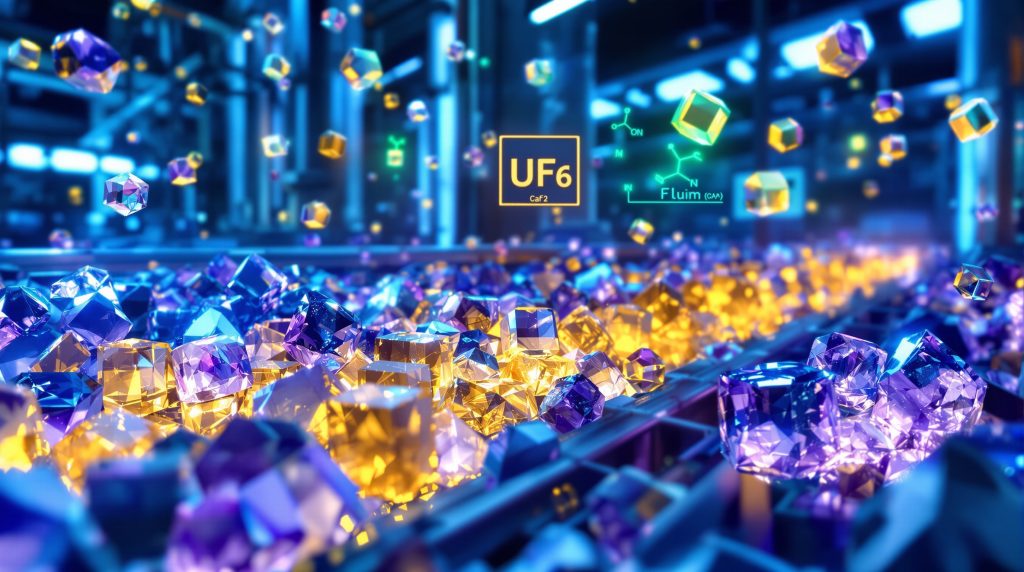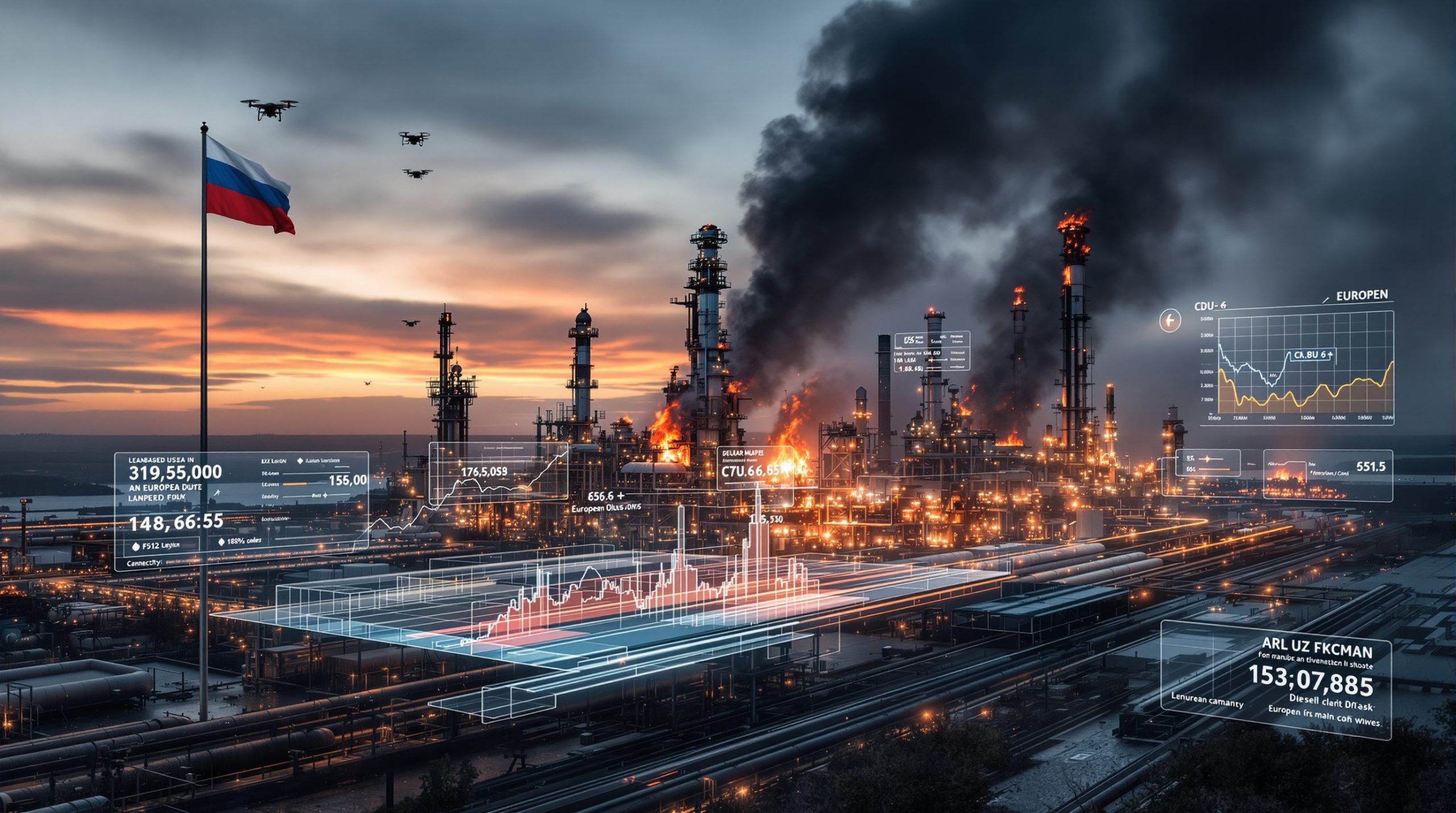The Chemical Foundation: From Mineral to Nuclear Fuel
Fluorspar, the commercial name for the mineral fluorite (CaF₂), serves as the essential starting point for creating fluorine compounds necessary in uranium processing. This mineral's unique properties make it irreplaceable in the nuclear fuel cycle for several critical reasons.
The mineral contains the highest concentration of fluorine (51.1% by weight) among commercially viable minerals, according to the U.S. Geological Survey's 2024 Mineral Commodity Summaries. Its cubic crystal structure—known as the fluorite structure—allows for efficient fluorine extraction with minimal energy input, while its high melting point of 1,418°C enables controlled processing in industrial furnaces.
For nuclear applications, acid-grade fluorspar with exceptional purity (97%+ CaF₂) is required, minimizing contaminants that could interfere with fluorspar's role in uranium enrichment. This grade exceeds purity requirements for steel and aluminum production by 15-20%, highlighting the specialized nature of nuclear-grade materials.
Global fluorspar reserves are estimated at 320 million tonnes, with China holding approximately 24% of world reserves according to USGS data. This concentration of resources creates potential supply vulnerabilities for countries dependent on nuclear energy.
When processed, fluorspar becomes the source of hydrofluoric acid (HF), which the World Nuclear Association describes as an "essential chemical" in the nuclear fuel cycle, with no practical substitutes available for uranium processing.
Grades and Applications
Fluorspar is classified into three main grades, each serving different industrial purposes:
- Acid-grade (97%+ CaF₂): Required for hydrofluoric acid production and nuclear applications
- Metallurgical-grade (85-97% CaF₂): Used primarily in steel and iron production
- Ceramic-grade (85-96% CaF₂): Utilized in glass, ceramics, and enamel manufacturing
The Gibellini Project in Nevada represents the first fully permitted primary fluorspar operation in the United States, highlighting domestic efforts to secure this critical mineral supply chain. Such developments gained urgency after China's export restrictions on fluorspar in 2010-2011 caused global price increases of 300-400%, dramatically demonstrating supply vulnerabilities.
How Does the Uranium Enrichment Process Work?
The transformation of raw uranium into nuclear fuel requires a complex, multi-stage process where fluorspar-derived chemicals play a critical role at each step. The International Atomic Energy Agency describes the conversion to uranium hexafluoride as "the most chemically challenging step" in the nuclear fuel cycle due to the highly corrosive nature of hydrofluoric acid.
Step 1: Creating Hydrofluoric Acid
The journey begins with converting acid-grade fluorspar into hydrofluoric acid through the following reaction:
CaF₂ + H₂SO₄ → 2HF + CaSO₄
This highly corrosive acid becomes the foundation for all subsequent fluorination steps in uranium processing. The reaction requires specialized equipment made from materials like Monel and Hastelloy to withstand the extremely corrosive conditions.
Step 2: Converting Uranium to Uranium Hexafluoride
Raw uranium concentrate (yellowcake) undergoes a series of chemical transformations:
- Uranium oxide is converted to uranium tetrafluoride (UF₄) using hydrofluoric acid
- UF₄ is then converted to uranium hexafluoride (UF₆) using fluorine gas (which is itself produced from hydrofluoric acid)
The chemical equations for these transformations are:
UO₂ + 4HF → UF₄ + 2H₂O
UF₄ + F₂ → UF₆
These reactions require temperatures of 500-600°C to ensure complete fluorination. Modern conversion facilities process between 15,000-20,000 tonnes of uranium per year, with the Honeywell Metropolis Works in Illinois being the only U.S. facility converting uranium to UF₆.
Step 3: Enrichment Through Physical Separation
UF₆ is the only uranium compound that can be readily converted to a gas at relatively low temperatures (56.5°C), making it ideal for enrichment processes. This unique property enables:
- Gaseous diffusion enrichment: Where UF₆ passes through semi-permeable membranes
- Gas centrifuge technology: Where UF₆ is spun at high speeds (exceeding 50,000 RPM) to separate isotopes
Both methods rely on the slight mass difference between ²³⁵UF₆ and ²³⁸UF₆ molecules to achieve isotopic separation, increasing the concentration of fissile uranium-235 from its natural 0.7% to the 3-5% needed for most nuclear reactors.
Modern enrichment facilities utilize cascades containing 1,000-5,000 centrifuges operating in parallel, with advanced US uranium production technology reducing energy consumption by 40-50% compared to older gaseous diffusion methods.
Step 4: Conversion Back to Solid Fuel
After enrichment, the UF₆ is chemically converted back to uranium dioxide (UO₂) powder, which is then pressed into ceramic pellets for use in nuclear fuel assemblies. The World Nuclear Association notes that enrichment from 0.7% to 3.2% U-235 requires approximately 4.3 kg of natural uranium per kg of enriched uranium.
The entire process from conversion to enrichment represents a delicate balance of chemistry, physics, and engineering—all made possible by fluorspar-derived compounds.
Why is Fluorspar Strategically Critical?
The indispensable role of fluorspar in uranium enrichment creates significant strategic implications for national security, energy independence, and industrial capabilities.
Supply Chain Vulnerabilities
The global fluorspar supply chain is highly concentrated and vulnerable to disruption. According to the U.S. Geological Survey's 2024 reports:
- The United States imports 100% of its fluorspar needs, with Mexico supplying 63% and China 22%
- China dominates global production, accounting for approximately 60% of world supply
- Mexico is the second-largest producer, providing about 18% of global supply
The U.S. Geological Survey emphasizes that fluorspar has "no adequate substitute" for hydrofluoric acid production in nuclear applications, making this dependency particularly concerning. The International Energy Agency identifies fluorspar supply concentration as a "significant risk factor" for nuclear energy expansion in its Energy Security Report.
Critical Mineral Status
Many countries have designated fluorspar as a "critical mineral" due to:
- Its essential role in strategic industries, including nuclear energy
- Limited substitution possibilities
- High supply risk due to production concentration
- Growing demand from competing sectors like refrigerants, aluminum production, and lithium-ion batteries
The U.S. Department of Energy has specifically highlighted fluorspar as crucial to energy security in its Critical Materials Strategy, emphasizing its importance to the nuclear fuel cycle.
Economic Implications
The economics of fluorspar production and processing create additional strategic considerations:
- Acid-grade fluorspar prices averaged $480-520 per tonne in 2023, representing a 15% increase from 2022, according to Industrial Minerals pricing data
- Processing fluorspar into hydrofluoric acid increases its value by 3-4 times
- The cost of fluorspar represents a small but critical component of overall nuclear fuel costs
- Price volatility can impact the economics of nuclear power generation
Nuclear-grade hydrofluoric acid requires 99.9% purity, achievable only through acid-grade fluorspar processing. This high-specification requirement further narrows supply options and increases strategic vulnerability.
Strategic Reserve Considerations
Several nuclear-powered nations maintain strategic stockpiles of critical minerals, including fluorspar or its derivatives. These reserves aim to mitigate short-term supply disruptions but face challenges:
- Specialized storage requirements due to HF's corrosive properties
- Limited shelf life for certain processed chemicals
- Significant financial investment for adequate stockpile volumes
- Strategic signaling concerns when building or depleting reserves
South Korea's nuclear program, which relies entirely on imported fluorspar, demonstrates this regional vulnerability. Similarly, the UK's strategic mineral review identified fluorspar as "critical" for energy security, highlighting the global nature of this concern.
Global Production and Market Dynamics
Understanding the global fluorspar landscape reveals key supply chain challenges and opportunities for diversification.
Major Producing Regions
The world's fluorspar production is highly concentrated in a few countries:
| Country | Percentage of Global Production | Annual Production (est. tonnes) |
|---|---|---|
| China | 60.0% | 4.0 million |
| Mexico | 18.3% | 1.1 million |
| Mongolia | 5.7% | 380,000 |
| South Africa | 2.8% | 190,000 |
| Vietnam | 2.3% | 160,000 |
This concentration creates significant leverage for major producing countries, particularly China, which has implemented export quotas and restrictions on fluorspar in the past. Industry analysts note that China's dominance creates "significant supply chain risk" for nuclear-dependent nations, according to the Critical Materials Institute.
Quality and Processing Variations
Fluorspar quality varies significantly between deposits, affecting its suitability for nuclear applications:
- Mexican fluorspar: Generally high purity with lower processing requirements
- Chinese fluorspar: Variable quality requiring more extensive beneficiation
- Mongolian fluorspar: Emerging producer with developing quality standards
- South African fluorspar: High-grade but with specific impurity profiles
These quality differences directly impact processing costs and final product specifications. Transportation costs represent 15-25% of delivered fluorspar prices due to weight and handling requirements, creating regional advantages for certain producers.
Import Dependencies
Nations with significant nuclear capacity face considerable strategic risk:
- The European Union imports approximately 85% of fluorspar requirements
- Japan and South Korea rely almost entirely on imports for their nuclear programs
- Canada, despite its substantial uranium production, imports most of its fluorspar needs
These dependencies create vulnerabilities that could potentially affect nuclear energy security during trade disputes or supply disruptions. The US uranium import ban has further highlighted concerns about critical mineral supply chains. Mexico's Las Cuevas mine supplies approximately 500,000 tonnes annually to North American markets, highlighting regional interdependencies.
Mining Methods and Environmental Considerations
Fluorspar extraction methods vary by deposit type and location:
- Open-pit mining: Common in larger deposits, offering lower costs but larger environmental footprints
- Underground mining: Used for deeper deposits, higher cost but often higher grade
- Artisanal mining: Still practiced in some regions, with variable environmental and labor practices
Each method presents different economic, environmental, and social considerations that influence the global supply landscape.
Technological Developments and Future Outlook
Several technological developments are shaping the future relationship between fluorspar and uranium enrichment, with significant implications for supply chains and resource utilization.
Advanced Enrichment Technologies
Newer enrichment technologies still require uranium hexafluoride but aim to reduce energy consumption and improve efficiency:
- Laser enrichment methods: Technologies like SILEX (Separation of Isotopes by Laser Excitation) claim 80% reduction in energy requirements per unit of enriched uranium
- Advanced centrifuge designs: Improve separation efficiency while maintaining dependence on fluorspar-derived chemicals
- Electromagnetic isotope separation: Revived with modern materials for specialized applications
China's advanced centrifuge program aims for 50% efficiency improvement by 2030, demonstrating ongoing innovation in this field. However, nuclear technology experts indicate that even advanced enrichment methods will continue requiring UF₆ as the primary feedstock, according to the World Nuclear Association's Technology Roadmap.
Recycling and Recovery Efforts
The nuclear industry is developing improved methods to maximize resource utilization:
- Fluoride recycling programs recover 60-70% of fluorine content from nuclear fuel processing waste
- Advanced recovery techniques focus on capturing fluorine compounds from gaseous effluent
- Closed-loop systems aim to minimize environmental releases while reducing fresh fluoride requirements
These initiatives reduce waste and environmental impacts from fluorine-containing compounds while potentially decreasing overall fluorspar requirements through more efficient processes.
Alternative Nuclear Fuel Cycles
Some advanced reactor designs explore alternative fuel cycles that may alter fluoride demand patterns:
- Thorium fuel cycles: Require different processing methods but still involve fluoride compounds
- Molten salt reactors: Use fluoride salts directly as both coolant and fuel carrier, potentially increasing per-reactor fluoride requirements
- Fast neutron reactors: May reduce enrichment requirements but utilize similar conversion processes
The U.S. HALEU (High-Assay Low-Enriched Uranium) program, which requires enhanced conversion capabilities, illustrates how evolving reactor technologies continue to rely on fluoride chemistry while potentially changing demand profiles.
Timeline for Technology Implementation
The implementation of these technologies follows distinct timelines:
- Near-term (1-5 years): Incremental improvements in existing processes and recovery methods
- Mid-term (5-10 years): Deployment of advanced centrifuge designs and enhanced recycling
- Long-term (10+ years): Commercial implementation of alternative fuel cycles and novel reactor designs
The IAEA projects that fluoride demand for nuclear applications will increase 25-35% by 2035 due to reactor construction programs, highlighting the growing importance of secure fluorspar supplies despite technological advancements.
Environmental and Safety Considerations
The use of fluorspar in uranium enrichment presents several environmental and safety challenges that require careful management throughout the nuclear fuel cycle.
Handling Hazardous Materials
The production and handling of hydrofluoric acid and uranium hexafluoride require extensive safety protocols:
- HF exposure limits are set at 3 ppm (8-hour time-weighted average) by OSHA
- Emergency response systems must neutralize HF releases within 2-3 minutes to prevent serious injury
- Specialized materials (Monel, Hastelloy) are required for HF-resistant equipment
The U.S. EPA emphasizes that fluoride compound handling requires "the highest level of safety protocols" due to extreme toxicity. International nuclear safety experts stress that proper HF handling is "fundamental to nuclear fuel cycle safety," according to IAEA Safety Standards.
Waste Management
The nuclear fuel cycle generates various fluoride-containing wastes that require careful management:
- Global depleted uranium hexafluoride (DUF₆) inventory exceeds 1.5 million tonnes
- Conversion of DUF₆ to more stable forms for long-term storage requires additional chemical processing
- Waste treatment processes convert fluoride compounds to calcium fluoride for disposal
The Paducah DUF₆ conversion facility processes 18,000 tonnes of depleted uranium annually, demonstrating the scale of waste management operations. France's La Hague facility showcases integrated waste management for fluoride compounds used throughout the nuclear fuel cycle.
Regulatory Frameworks
Strict regulatory oversight governs the entire process:
- Nuclear fuel processing facilities must maintain containment systems with 99.9% efficiency ratings
- International Atomic Energy Agency (IAEA) safeguards monitor uranium hexafluoride to prevent diversion
- National regulatory bodies impose rigorous safety and environmental standards
- Transportation of fluoride compounds is subject to hazardous materials regulations
Accident Case Studies and Lessons Learned
Historical incidents have shaped modern safety practices:
- The 1986 Gore, Oklahoma UF₆ release demonstrated the rapid reaction of UF₆ with atmospheric moisture
- Multiple HF releases in processing facilities led to improved containment and detection systems
- Transportation incidents prompted enhanced packaging and emergency response protocols
These events have resulted in continuously improving safety standards, monitoring systems, and emergency preparedness throughout the nuclear fuel cycle.
The Inseparable Link Between Fluorspar and Nuclear Energy
Fluorspar's role in uranium enrichment represents a perfect example of how a seemingly ordinary mineral can become strategically critical through its application in advanced technologies. The relationship between fluorspar and nuclear energy creates a complex web of chemical, industrial, economic, and geopolitical considerations that directly impact global energy security.
The chemical uniqueness of fluorine—derived from fluorspar—makes it irreplaceable in uranium processing. Its ability to form volatile compounds with uranium enables the entire enrichment process that powers nuclear reactors worldwide. This chemical necessity creates a permanent link between mineral resources and energy production that transcends technological evolution.
Supply chain security for fluorspar directly impacts energy security for nuclear-powered nations. The concentration of production, limited substitution possibilities, and growing demand from competing industries ensure that fluorspar will continue to be a mineral of critical importance to the global energy landscape.
As nuclear power continues to play a significant role in low-carbon energy strategies worldwide, securing stable supplies of fluorspar will remain a strategic priority. Nations pursuing energy independence must consider not only uranium resources but also the supporting minerals that make nuclear energy possible.
The interconnections between mining, chemical processing, nuclear technology, and energy production highlighted by the fluorspar-uranium relationship demonstrate the complex material foundations of modern energy systems. Understanding these critical mineral dependencies provides valuable insights for policymakers, industry stakeholders, and investors navigating the complex intersection of mineral resources, energy security, and technological development in a carbon-constrained world.
Recent uranium market volatility and a uranium mining halt in some regions further underscore the importance of developing comprehensive uranium market strategies that account for all critical inputs, including fluorspar.
Disclaimer
This article provides information for educational purposes only. The nuclear fuel cycle involves complex technical, regulatory, and safety considerations that require professional expertise. Forecasts regarding mineral supplies, technological developments, and market trends involve inherent uncertainties and should not be considered investment advice.
Ready to Invest in the Next Major Mineral Discovery?
Unlock instant alerts on significant ASX mineral discoveries through Discovery Alert's proprietary Discovery IQ model, which transforms complex mineralisation data into actionable insights. Understand why historic discoveries can generate substantial returns by visiting Discovery Alert's dedicated discoveries page and begin your 30-day free trial today to position yourself ahead of the market.




